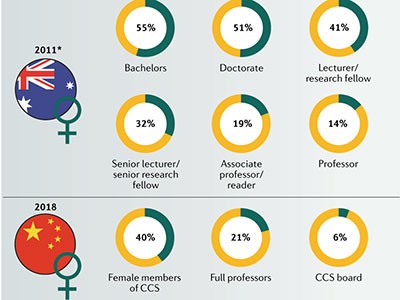
Women are under-represented in the chemistry and physics communities within academia.Credit: Monty Rakusen/Getty
When it comes to diversity in science, the data paint a consistently depressing picture. A 2018 survey and report from the UK Royal Society of Chemistry showed that 44% of undergraduates beginning chemistry degrees are women, compared with only 9% of chemistry professors (see go.nature.com/2v7mdfv). But there is at least a growing recognition that we need data to document the issues and work out how best to address them.
With this in mind, two articles, published this week in Nature Reviews Chemistry and Nature Reviews Physics, collate statistics on women in the academic chemistry and physics communities around the world, and look at how these data can guide interventions (M. Peplow Nature Rev. Chem. https://doi.org/10.1038/s41570-019-0098-y (2019) and R. Skibba Nature Rev. Phys. https://doi.org/10.1038/s42254-019-0059-x; 2019).
The barriers start young. Teenage girls in developed countries, for example, are less likely than boys with similar academic marks to aspire to a job that involves using mathematics, according to a survey of students in 32 countries (M. Charles Socius http://doi.org/c5cm; 2017) — and if they do choose to pursue such a career path, they encounter obstacles at every step. The result? Yawning inequalities at the most senior levels of academia.
Although both chemistry and physics have a major leaky-pipeline problem, in physics, girls and women are also much less likely to study the subject at all, according to the Nature Reviews Physics article. And yet reliable data on gender and other metrics of diversity are patchy. The 2018 Royal Society of Chemistry survey, and data collected by learned societies around the world — such as the Max Planck Society and the US National Science Foundation — are valuable starts. Such surveys need to be updated regularly and, ideally, standardized to allow for comparison. There is also a pressing need to explore how the numbers differ in various regions and cultures of the world, and how best to address them within their respective contexts.
But data alone are not going to deliver change. What matters more is to act on them. STEP UP 4 Women, run by the American Physical Society, is just one example of a programme that produces material for high-school teachers to help inspire young women to pursue undergraduate degrees in physics. Many would argue that we need to start such efforts well before this age, to avoid stereotypes that become engrained early on.
Addressing diversity requires a suite of solutions, and a firm resolve. Better mentoring and support of those from under-represented groups could prevent talented researchers from being driven out of academia (A. M. Kloxin Nature Rev. Mater. http://doi.org/c5ck; 2019).
Some scientists leave research because of the challenge of squaring academic demands with other responsibilities, such as caring for an elderly relative or raising a family. One essential step is the development of better policies for promoting work–life balance — from simple department-wide initiatives, such as scheduling meetings at family-friendly times, through research-community initiatives (for example, conference scheduling and providing childcare at conferences), right up to nationwide policies that offer generous, and preferably equally shared, parental leave.
It is encouraging to see more policies and initiatives emerging to promote women and other under-represented groups in research. Collecting data to assess their impact and show what works is also important. But real improvements to diversity will be achieved only through widespread resolve and action on every front.



 Women’s work
Women’s work
 Women in physics
Women in physics
 Female physicists make slow academic headway in the United States
Female physicists make slow academic headway in the United States


